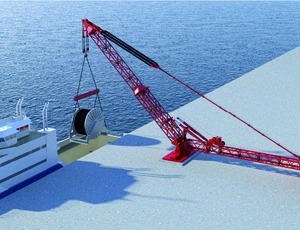
As more of the world demands electricity, the job of building powerplants in remote locations remains a huge logistical challenge that often requires expensive infrastructure and equipment to move the bulky plant components from ship to shore. Heavy-lifting and rigging firm Mammoet has developed a special-use crane designed to tackle the problem.
The MTC-15, or Mammoet Terminal Crane, can lift loads weighing 550 tons at a radius of about 100 ft. According to the Netherlands-based company, the MTC-15 lifts as much as a 1,300-ton crawler crane, but it deploys in less time and does not require special ground improvements to operate safely.
"Some of these plants are being built in remote locations—therefore, the importance to mobilize in a very flexible and cost-effective manner is going to be more important in the future," says Guus Stigter, vice president of sales and marketing for Mammoet's U.S. division in Rosharon, Texas. The derrick is essentially a stationary crane designed to off-load ships and barges at small ports where it may not be feasible to bring in heavy-lift vessels or erect large-capacity crawler cranes.
One assist crane rated at roughly 90 tons of load capacity is required to set up the MTC-15, which erects in 10 days. Once it is up and running, only one person is needed to operate the crane.
Costing about $6.4 million, the unit breaks down into 25 standard, 20-ft-long shipping containers. As with other Mammoet cranes, the MTC-15 containers can be filled with water bags or sand to act as counterweight. The containers can hold up to 440 tons total.
The derrick can perform lifts from a small port, quay or riverbank. The boom has a maximum hook height of 115 ft and can reach out from 23 ft to 135 ft. With a standard 550-ton capacity and ground- bearing pressure of 14.2 pounds per square inch, the crane's footprint on the ground extends up to 49 ft wide and 128 ft long. Although the MTC-15 is designed to work without special foundations, its capacity and ground pressure can be tweaked with additional engineering.
Mammoet spends about 2% of its $2 billion in annual revenue on research-and-development projects like the MTC-15. "It's a great construction tool, which we think the market is going to need in the next few years," says Stigter.


Post a comment to this article
Report Abusive Comment